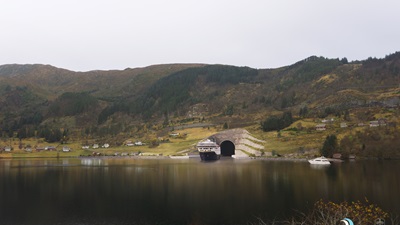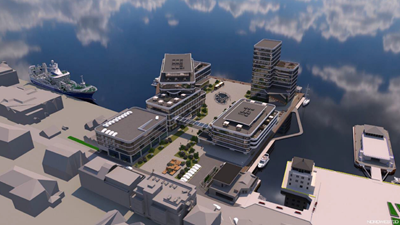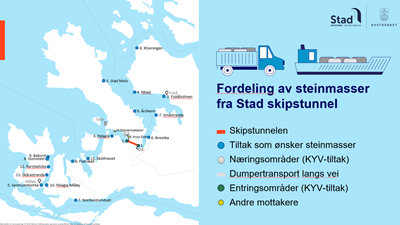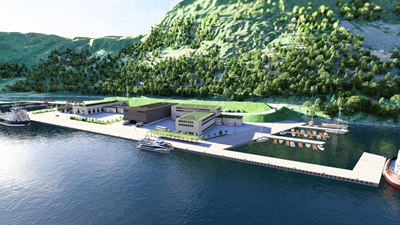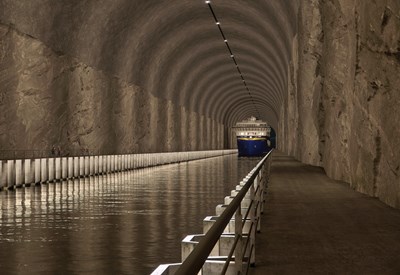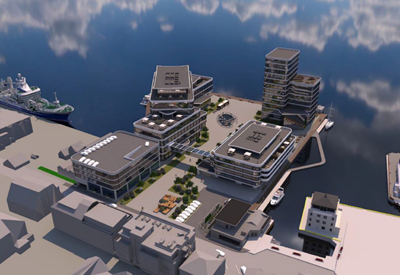- We are focused on optimizing the Stad ship tunnel project and to create the maximum possible benefit. This includes reusing the stone from the ship tunnel in a sensible manner, says Terje Skjeppestad, project manager for the Stad ship tunnel, who describes a lengthy and thorough process to finalize the prioritization list:
- There are many good initiatives in the municipalities that will create new commercial areas and more job opportunities, says Skjeppestad.
Large dimensions and a lot of stone
The dimensions of the ship tunnel are massive. With a height of 50 meters, a width of 36 meters and a length of 1700 meters, there are large quantities of stone to be extracted from the tunnel openings. In total, over three million cubic meters of solid rock from the tunnel will be removed, which is nearly six million cubic meters of blasted stone masses.
In the municipalities surrounding the ship tunnel, there is a shortage of stone masses, and interest among recipients has been and continues to be significant. Stone from the ship tunnel can provide several new commercial areas in the region and many new job opportunities. Municipalities and business owners have invested a lot of time and resources in regulatory work to be able to receive the stone masses.
- The realization of the Stad ship tunnel will provide stone masses for several new commercial areas in Vanylven, both for Prodtex’s facility at Fiskåholmen and MOWI’s facility at Sighaug. These new commercial areas, along with the tunnel, will contribute to increased growth and many new job opportunities in our municipality and region. It is now important that the ship tunnel is completed so that we can implement these initiatives, says municipal director Andreas Christian Nørve in Vanylven.
Important prioritization
- It has been important for the Norwegian Coastal Administration that the municipalities of Stad, Vanylven and Kinn agree with us regarding which projects should be prioritized for receiving stone from the Stad ship tunnel. A key element for the Norwegian Coastal Administration has also been that all three municipalities have projects designated to receive stone, says Skjeppestad.
He receives support from Kinn municipality.
- Kinn is pleased with the process from the Norwegian Coastal Administration that will distribute the stone masses in a way that promotes the aspects the municipality is concerned about. The relevant projects in Kinn are all associated with existing commercial areas and, if they receive stone, they will be able to expand their operations. This will lead to increased value creation and strengthen an already proactive community, says municipal director Øyvind Bang-Olsen in Kinn.
The prioritization of who can receive stone masses has been done based on factors such as the maturity of the projects, their utility, and costs. In principle, equal amounts of stone are to be extracted on both sides of the ship tunnel.
- Unfortunately, we do not have enough stone masses for all the initiatives”, says Skjeppestad.
The Norwegian Costal Administration, in collaboration with the three municipalities, has agreed upon the following prioritized list:
North of the ship tunnel
|
|
|
Registrered mass requirement in m3 |
|
|
Portal area Kjøde |
Stad (KYV initiative) |
Quality controlled |
1 |
|
Kjøde industrial area |
Stad (KYV initiative) |
Quality controlled |
2 |
|
Fiskåholmen |
Vanylven |
372 000 |
3 |
|
Mowi, Sighaug |
Vanylven |
115 000 |
4 |
|
Stad Molo, Leikanger |
Stad |
Quality controlled |
5 |
|
Breivika |
Vanylven |
1 120 000 |
6 |
|
Småstranda |
Vanylven |
699 000 |
7 |
|
Klovningen |
Vanylven |
250 000 |
8 |
|
Årsheim |
Stad |
700 000 |
9 |
South of the ship tunnel
|
|
|
Registered mass requirement in m3 |
|
|
Portal area Moldefjorden |
Stad (KYV initiative) |
Quality controlled |
1 |
|
Lesto industrial area |
Stad (KYV initiative) |
Quality controlled |
2 |
|
Pelagia (Pelagia and Stad Municipality), Moldefjorden |
Stad |
233 000 |
3 |
|
Eide-interchange, Moldefjorden |
Stad (VFK interchange) |
30 000 |
4 |
|
Sentrumstomta Måløy |
Kinn |
326 000 |
5 |
|
Flatraket Industribygg |
Stad |
40 000 |
6 |
|
Nordvestvinduet, Allmenning |
Kinn |
300 000 |
7 |
|
Domstein, Raudeberg |
Kinn |
50 000 |
8 |
|
Babord, Raudeberg Maritime Park |
Kinn |
55 000 |
9 |
|
Pelagia, Måløy/Deknepollen |
Kinn |
55 000 |
10 |
|
Skårastranda |
Kinn |
375 000 |
11 |
|
Barstadvika, Nordfjord Port |
Kinn |
258 000 |
12 |
|
Skottneset |
Stad |
Uncertain |
13 |
|
Moldefjorden (deep-sea disposal) |
Stad (KYV disposal) |
Hopefully not relevant |
14 |
